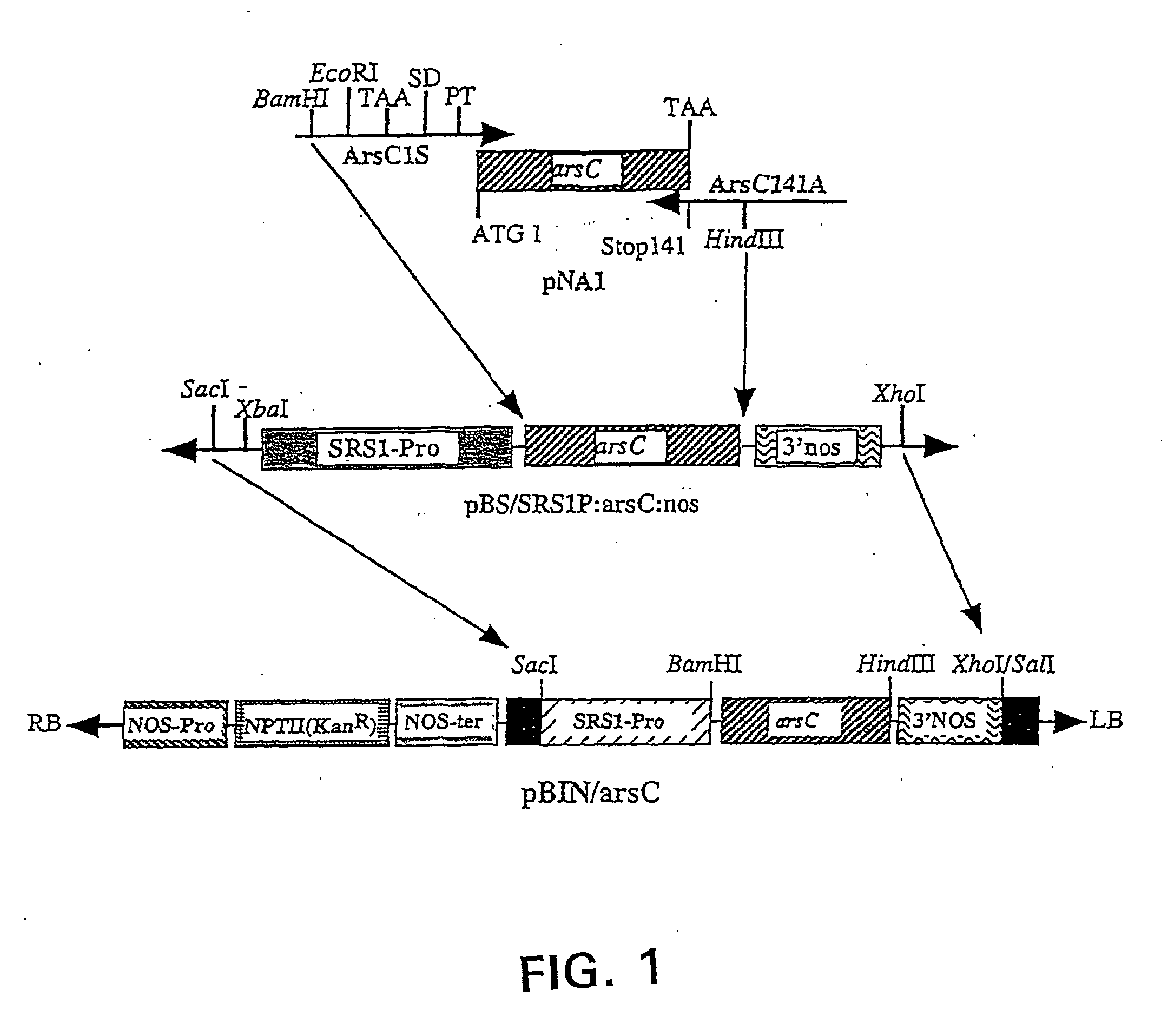Metal resistant plants and phytoremediation of environmental contamination
a technology of metal resistant plants and phytoremediation, applied in the field of plant molecular biology, can solve the problems of cadmium accumulation, cadmium accumulation, cu, zn, pb, etc., and achieve the effect of reducing the amount of cadmium in the solid state, and increasing the level of cadmium
- Summary
- Abstract
- Description
- Claims
- Application Information
AI Technical Summary
Benefits of technology
Problems solved by technology
Method used
Image
Examples
example 1
Strains and Plasmids
[0136]Escherichia coli strain AW10 contains plasmid pArsAB200 which has the arsA and arsB genes, E. coli JM109 contains plasmid pAlter-C which bears the arsC gene, and E. coli RW3110 is a strain in which a Zn (II) / Cd (II) pump gene termed as zntA is knocked out, as described previously (Carlin et al., 1995; Rensing et al., 1997). The pBluescriptSK (−) plasmid (Stratagene, La Jolla, Calif.) and promoterless binary vector pBIN19 (Clontech, Palo Alto, Calif.), designed for expressing genes under promoter of interest by Agrobacterium-mediated transformations, were obtained commercially.
example 2
Reconstruction of arsC for Plant Expression
[0137] The 141-codon arsC gene was amplified by PCR using long synthetic primers that modified the arsC flanking sequences as shown in FIG. 1A. The sense primer, ArsC1S consisted of the 56 nt sequence 5′-TACGTCGGATCCGAATTCGTCGACTAAGGAGGAGCCACAATGAGCAACATCACTAT-3′ (SEQ ID NO:1) and contained BamHI, EcoRI and SAlI cloning sites, a TAA stop codon to end the translation of an upstream β-galactosidase fusion protein in E. coli, a GGAGGA bacterial translation signal to improve expression in E. coli, an AGCCACA consensus sequence for plant translation (Heidecker and Menning, 1986), an ATG start codon and the first 17nt of the arsC coding sequence to prime the forward PCR reaction (Rugh et al., 1996). The antisense primer, ArsC141A, had the 40 nt sequence 5′-TAGGTCGGATCCGAATTCAAGCTTATTATTTCAGCCGTTT-3′ (SEQ ID NO:2), with HindIII, EcoRI and BamHI cloning sites and anticodons to the last 4 arsC codons to prime the reverse PCR reaction. PCR was carri...
example 3
Disk Sensitivity Assays
[0139] Sodium arsenate and cadmium chloride (Sigma Chemical Co., St. Louis, Mo.) solutions were prepared in sterile water. Because of the extreme toxicity membrane permeability of these chemicals, dry stocks, and stock solutions were handled using protective clothing, eye protection, and double layers of gloves. All metal ion-sensitivity filter disk assays were performed in the presence of ampicillin to maintain the pBSSKII plasmid, as described in Rugh et al., 1996. The data reported are the average results of three replicates. Approximately 2×108 cells carrying the lac-regulated arsC sequence were plated in top agar on LB medium containing IPTG (1 mM final concentration) and appropriate antibiotics. 5 or 10 μl aliquots of metal ion solution (100 mM CdCl2 or 250 mM As2O5) was pipetted onto 6 mm diameter sterile 3 mm Whatman paper disks, which were placed on solidified top agar containing the strains of interest. The plates were incubated overnight at 37° C.,...
PUM
| Property | Measurement | Unit |
|---|---|---|
| temperature | aaaaa | aaaaa |
| temperature | aaaaa | aaaaa |
| melting temperature | aaaaa | aaaaa |
Abstract
Description
Claims
Application Information
 Login to View More
Login to View More - R&D
- Intellectual Property
- Life Sciences
- Materials
- Tech Scout
- Unparalleled Data Quality
- Higher Quality Content
- 60% Fewer Hallucinations
Browse by: Latest US Patents, China's latest patents, Technical Efficacy Thesaurus, Application Domain, Technology Topic, Popular Technical Reports.
© 2025 PatSnap. All rights reserved.Legal|Privacy policy|Modern Slavery Act Transparency Statement|Sitemap|About US| Contact US: help@patsnap.com



